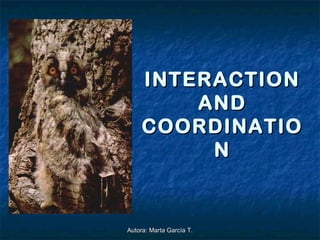
INTERACTION AND COORDINATION
- 1. INTERACTION AND COORDINATIO N Autora: Marta García T.
- 2. What do you remember? 1. What senses does a predatory animal use when it hunts? 2. What body part does the chameleon use to catch its prey? 3.What type of living being moves more quickly: a plant or an animal? 4. Which of the following are involved in interaction? heart – roots – runners – brain - kidneys - bones Autora: Marta García T.
- 3. What is interaction? Interaction enables living beings to receive and respond to a stimulus. It involves different elements: 1. Stimuli. 2. Receptors. 3. Coordination Systems. 4. Effectors. Autora: Marta García T.
- 4. Stimuli → Detectable changes in the internal or external environment, which provoke responses. Stimuli can be Physical, Chemical or Biotic. Receptors → Sensory structures which detect external and internal stimuli. In Animals, receptors are the sense organs. In Plants, repectors are found in cells. Coordination Systems → Organs which process information received by the receptors and produce a response. Effectors → Structures which produce responses, such as muscles and glands in animals. Autora: Marta García T.
- 5. How do receptors work? SENSE SENSE ORGAN WHAT STIMULI DO THEY DETECT? HOW DO THEY WORK? They detect light. SIGHT Eyes SMELL Vertebrates: nose They detect chemical substances Arthropods: appendage dissolved in air or water. TASTE Tongue It detects chemical substances dissolved in water. HEARING Ears They detect sound, from very loud noises to soft musical notes. TOUCH Fish: lateral line They detect pressure, touch, pain and Arthropods: appendage temperature changes Most animals: skin Autora: Marta García T.
- 6. Autora: Marta García T.
- 7. Coordination System: The Nervous System The nervous system receives information, interprets it, and transmits a response to the effectors. It is different for invertebrates and vertebrates. Autora: Marta García T.
- 8. In vertebrates, the nervous system includes: The Central Nervous System (CNS ) → The Brain and the Spinal Cord. The Peripheral Nervous System (PNS )→ Nerves originated in the brain and in the spinal cord. Nerves can be: Sensory: go from the receptors to the CNS, carrying information. Motor: go from the CNS to the effectors, carrying a response. Autora: Marta García T.
- 9. Autora: Marta García T.
- 10. Invertebrates have simpler nervous systems, for example: Ganglia system (nerve cells are joined by the nerve cord). Nerve Net system (nerve cells form a nerve net extending throughout the animal). Autora: Marta García T.
- 11. Effectors They are organs which produce a response. There are two types of responses to stimuli: MOTOR RESPONSES →The response is movement. They are controlled by the motor system ENDOCRINE RESPONSES → The response is the release of hormones into the blood. Hormones control and coordinate activities throughout the body. They are controlled by glands. Autora: Marta García T.
- 12. Autora: Marta García T.
- 13. Coordination In Plants Plants do not have a nervous or an endocrine system. Responses to stimuli in plants are coordinated by HORMONES , which act as chemical messengers to respond to factors such as light, gravity, water and temperature. Cells inside the organism detect stimuli Autora: Marta García T.
- 14. There are two types of responses to external stimuli: 1) Tropism → Permanent responses which produce changes in the direction of the plant’s growth. Types: Geotropism: The response is caused by gravity. Phototropism: The response is caused by light. Autora: Marta García T.
- 15. Hydrotropism: The response is caused by water. Thigmotropism: The response is caused by contact. Autora: Marta García T.
- 16. 2) Nastic Movements: are temporary responses of particular parts of a plant to external stimuli. Autora: Marta García T.